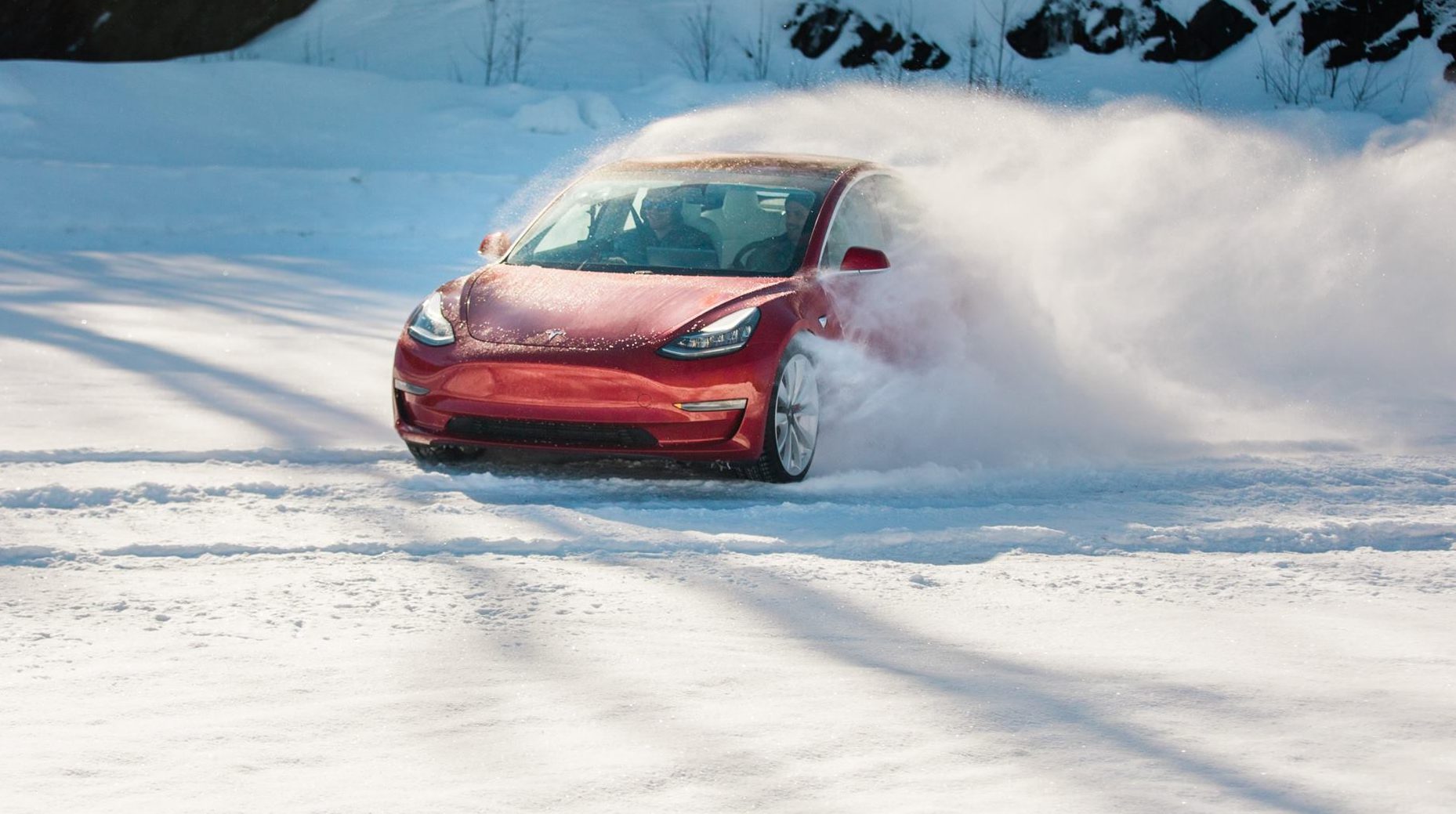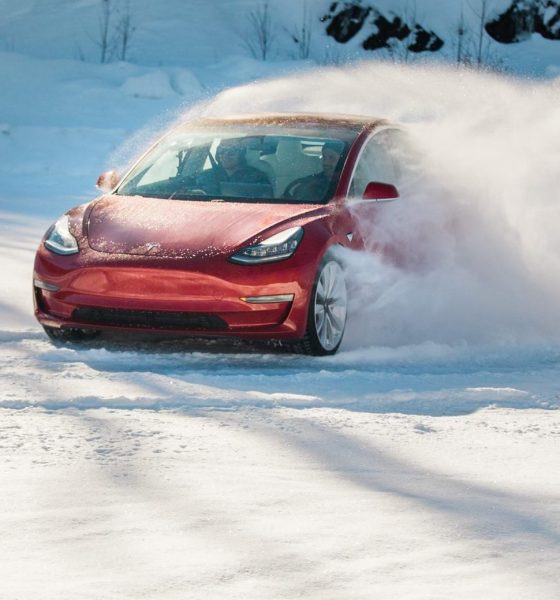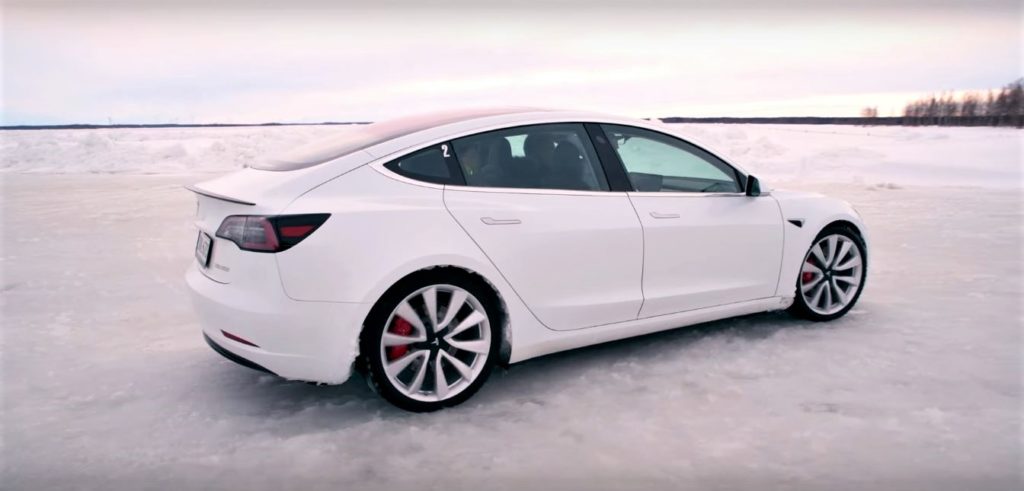

News
Tesla owners' winter driving insights proves EVs' are great cars for sub-zero conditions
Thanks to outdated assumptions and what appears to be an ongoing misinformation campaign against electric cars, some mainstream car buyers may assume that vehicles like the Tesla Model 3 would be grossly ineffective in sub-zero temperatures. Yet despite this persistent stereotype, actual experiences from electric car owners have recently proven these notions wrong once again.
Tesla owner and president-founder of the Saskatchewan Electric Vehicle Association Matthew Pointer recently shared some of his winter driving experiences with CBC News. A resident of Saskatchewan, Canada, Pointer is no stranger to cold weather driving. His home, after all, experiences sub-zero temperatures on a regular basis, at times requiring him to drive in -45 C (-49 F) weather. If the stereotype holds true, then Pointer’s Tesla should be near-useless in certain parts of the year. But this has not been the case.
On the contrary, Pointer stated that his Tesla actually works better than his previous internal combustion cars in the cold. While he stated that his electric vehicle does experience some range loss during winters, the car works perfectly in extreme weather. Just this Thursday, for example, Pointer noted that he passed by several dozen ICE owners struggling to start their vehicles on his way to work. His Tesla, in comparison, handled the cold without any issues, even with its reduced range.

“I passed several dozen people that couldn’t even get their car started in front of their house this morning, as I kind of ripped by them in my electric vehicle that apparently doesn’t work in those sort of temperatures. I wake up with a ‘full tank’ every morning because I plug in at night, and I wake up, and my car’s fully charged in the morning. I’ve got more than enough range to do all the regular stuff that I need to do on a daily basis,” Pointer said.
Explaining further, the Tesla owner stated that it’s just a matter of design between EVs and internal combustion cars. Electric cars have far fewer components compared to gasoline or diesel-powered automobiles. Thus, there are far fewer things that can get compromised by the cold. Couple this with Tesla’s excellent battery management system, and the company’s vehicles become incredibly effective for winter.
“The great thing about an electric vehicle is that it has significantly less moving parts, and you’re essentially driving one massive battery that’s very good at maintaining its heat and keeping itself going. There’s no moving parts that need to go through this magical movement and means of combustion and getting things preheated all at a minus-45-degree temperature. Essentially for us to start our cars, we just touch a button, the screen pops up, and we just drive to work from there,” he explained.

In a statement to the publication, Tyler Krause, a fellow resident of Saskatchewan and a Tesla Model 3 owner, described how easy it is to live with an electric car during the coldest months of the year. “Yesterday it was -37 C (-34.6 F), and it wasn’t a problem. I went to heat it up. It took like 10 minutes and I was off. I drove by probably three or four people that were getting boosted on the side of the road and I had no issues,” he said, adding that none of the local Tesla Owners Club members have reported any issues during winter.
Perhaps one thing that usually gets forgotten by electric vehicle critics is the fact that all cars, even those powered with the internal combustion engine, lose range during the coldest months of the year. With this in mind, it all comes down to convenience, and based on the accounts of actual Tesla owners from one of the colder places in North America; EVs have ICE beat by a wide margin. The proof lies in actual experiences from Tesla owners, as well as the company’s sales figures from cold countries such as Norway and the Netherlands, where the Model 3 has been making its presence known.

Elon Musk
Elon Musk’s Biggest Revelations on AI, Robots, and the Future of Work from the Moonshots Podcast

Elon Musk’s appearance on the Moonshots with Peter Diamandis podcast was packed with bold predictions, candid admissions, and surprising tech insights. The nearly three-hour conversation covered everything from artificial intelligence to humanoid robots, geopolitics, and the future of work. Here are the top 10 most intriguing takeaways:
-
Aggressive AGI Timeline Predictions
Musk offered a detailed view on when artificial general intelligence (AGI) could emerge, suggesting it may arrive sooner than many expect, emphasizing both transformative potential and risks.
-
U.S. vs. China in the AI Race
He discussed the strategic competition between the United States and China over AI development, noting that geopolitical dynamics will shape how and who leads in the next decades.
-
Future of Job Markets
Musk touched on how AI and automation could reshape employment, predicting massive boosts in productivity alongside potential disruptions in traditional work structures.
-
Clean Energy Transition
A recurring theme was the role of clean energy in future economies, with Musk reiterating the importance of scaling sustainable power generation and storage.
-
Humanoid Robots Are Coming
On the podcast, Musk elaborated on Tesla’s work on humanoid robots, hinting at timelines and applications that go beyond factories to general-purpose assistance.
-
Tesla Roadster “Last Human-Driven Car”
Outside the core discussion topics, Musk teased features of the upcoming Tesla Roadster — calling it “the best of the last of the human-driven cars” and suggesting safety won’t be its main selling point.
-
The Role of AI in Clean Energy and Robotics
Linking AI to both energy optimization and robotics, Musk explained how smarter systems could accelerate decarbonization and task automation across industries.
-
U.S. Innovation Leadership
Musk argued that maintaining American leadership in key tech sectors like AI, space, and robotics should be a national priority, with thoughtful policy and investment.
-
Job Creation vs. Job Elimination
While acknowledging automation’s disruptive effects, he also outlined scenarios where new industries and opportunities could emerge, particularly in AI, space, and advanced manufacturing.
-
Long-Term Vision for Humanity
Throughout the conversation, Musk revisited his long-term philosophical views — including a belief in humanity’s responsibility to become a multi-planetary and technologically empowered species.
Whether you agree with Musk’s optimism or not, the podcast offers a window into the thinking of one of the most influential figures in tech today, in and why his visions continue to spark debate and inspiration.
Elon Musk
Elon Musk just said some crazy stuff about the Tesla Roadster

Elon Musk appeared on the Moonshots podcast with Peter Diamandis today to discuss AGI, U.S. vs. China, Tesla, and some other interesting topics, but there was some discussion about the upcoming unveiling of the Roadster, the company’s electric supercar that will arrive several years after it was initially slated for release.
Musk made some pretty amazing claims about the Roadster; we already know it is supposed to be lightning-fast and could even hover, if Tesla gets everything to happen the way it wants to. However, the car has some pretty crazy capabilities, some of which have not even been revealed.
On the podcast, Musk said:
“This is not a…safety is not the main goal. If you buy a Ferrari, safety is not the number one goal. I say, if safety is your number one goal, do not buy the Roadster…We’ll aspire not to kill anyone in this car. It’ll be the best of the last of the human-driven cars. The best of the last.”
🚨 Elon on the Roadster unveiling, scheduled for April 1:
— TESLARATI (@Teslarati) January 6, 2026
Musk makes a good point: people who buy expensive sports cars with ridiculous top speeds and acceleration rates do not buy them to be safe. They hope they are safe in case of an emergency or crash, but safety is not at the forefront of their thoughts, because nobody buys a car thinking they’ll crash it.
The Roadster is truly going to push the limits and capabilities of passenger vehicles; there’s no doubt about that. Tesla plans to show off the new version car for the first time on April 1, and Musk has only hinted at what is possible with it.
Musk said back in November:
“Whether it’s good or bad, it will be unforgettable. My friend Peter Thiel once reflected that the future was supposed to have flying cars, but we don’t have flying cars. I think if Peter wants a flying car, he should be able to buy one…I think it has a shot at being the most memorable product unveiling ever. [It will be unveiled] hopefully before the end of the year. You know, we need to make sure that it works. This is some crazy technology in this car. Let’s just put it this way: if you took all the James Bond cars and combined them, it’s crazier than that.”
Production is set to begin between 12 and 18 months after the unveiling, which would put the car out sometime in 2027. Hopefully, Tesla is able to stay on track with the scheduling of the Roadster; many people have been waiting a long time for it.
News
Tesla launches hiring for Robotaxi program in its twentieth country
Overall, the hiring signals Tesla’s aggressive timeline for global dominance in autonomous mobility.

Tesla has launched a hiring initiative for its Robotaxi program in its twentieth country, as the company posted two new jobs in Thailand this week.
Tesla is hiring in Bangkok and Kowloon for the Vehicle Operator position, which is related to data collection, and is the first in Thailand, but the twentieth country overall, as the company tries to expand into other markets.
🚨 BREAKING: Tesla is hiring additional full-time Vehicle Operators in Bangkok, Thailand.
Previous openings were 6-month, part-time roles. These are equivalent to AI Safety Operator roles in the U.S. pic.twitter.com/R6LzoU1bos— Tesla Yoda (@teslayoda) January 5, 2026
Tesla has had active job postings for Vehicle Operator positions in the United States, India, Israel, Taiwan, Germany, the Czech Republic, Hungary, the UK, Finland, Switzerland, Sweden, the Netherlands, Austria, Spain, Norway, Italy, and Turkey in past listings.
These postings are not all currently available, likely because the roles have been filled.
Thailand is the most recent, and broadens the company’s potential path to expanding its ride-hailing program, which is only active in the United States in Austin, Texas, and the California Bay Area, so far.
These roles typically involve data collection, which assists in improving Autopilot and Full Self-Driving operation. Tesla’s self-driving programs utilize real-world data that is accumulated and stored, observing vehicle and traffic behavior, as well as tendencies that are performed by human drivers to help increase safety and overall performance.
Overall, the hiring signals Tesla’s aggressive timeline for global dominance in autonomous mobility. Although the company has several high-profile rivals and competitors in the field, it has established itself as a main player and a leader in the development of autonomous technology, especially in the U.S., as its FSD suite is refined on almost a weekly basis.
The Full Self-Driving suite is available in seven countries and territories currently, including the U.S., Canada, China, Mexico, Puerto Rico, Australia, and New Zealand. Its biggest goal for expansion is currently the European market, where regulatory hurdles have been the main bottleneck prolonging its launch on the continent.
Tesla has performed months of testing in various European countries, including France and Spain, and does have support in some areas from various regulatory agencies. However, the company is hoping to get through this red tape and offer its suite in Europe for the first time, hopefully this year.








